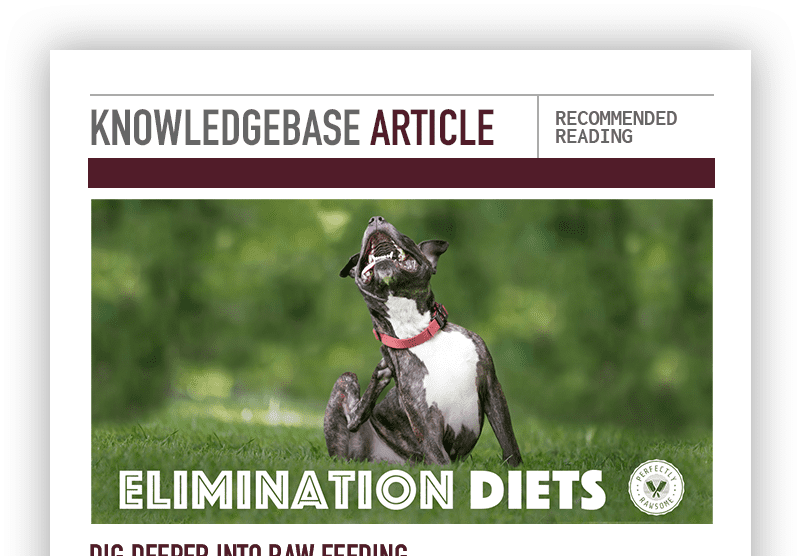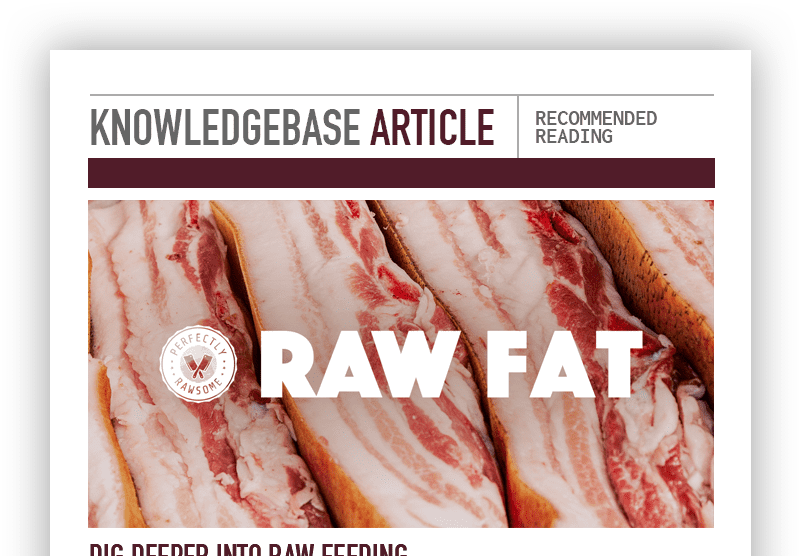Pork has been unfairly vilified as an unhealthy or unclean meat. The myths spread about pork have resulted in many raw feeders that refuse to feed pork to their pets. However, pork can be a nutritious and affordable protein to use in raw and cooked diets for dogs and cats.
There are many myths surrounding pork. Some of these myths are based on half truths and past problems, while others are inaccurate. These myths stem from a misunderstanding of the protein and how it can be used in cooked or raw diets. The most common myths include:
Source of Infectious Parasites
Many raw feeders are afraid to feed pork due to the belief that pork is riddled with parasites.
Source of Deadly Viruses
Wild boar can carry a deadly virus that has been eradicated in domesticated swine in developed countries. Pet parents may avoid feeding pork due to this misunderstanding.
Difficult to Digest
It is often assumed that all pork is high in fat and can therefore cause gastrointestinal complications.
Concentrated in Harmful Toxins
Some believe that pork meat is full of toxins because pigs are dirty animals and cannot sweat to excrete toxins.
Inferior Source of Nutrition
Pork meat is often considered of little nutritional value in raw or cooked diets due to the multiple myths surrounding the consumption of it.
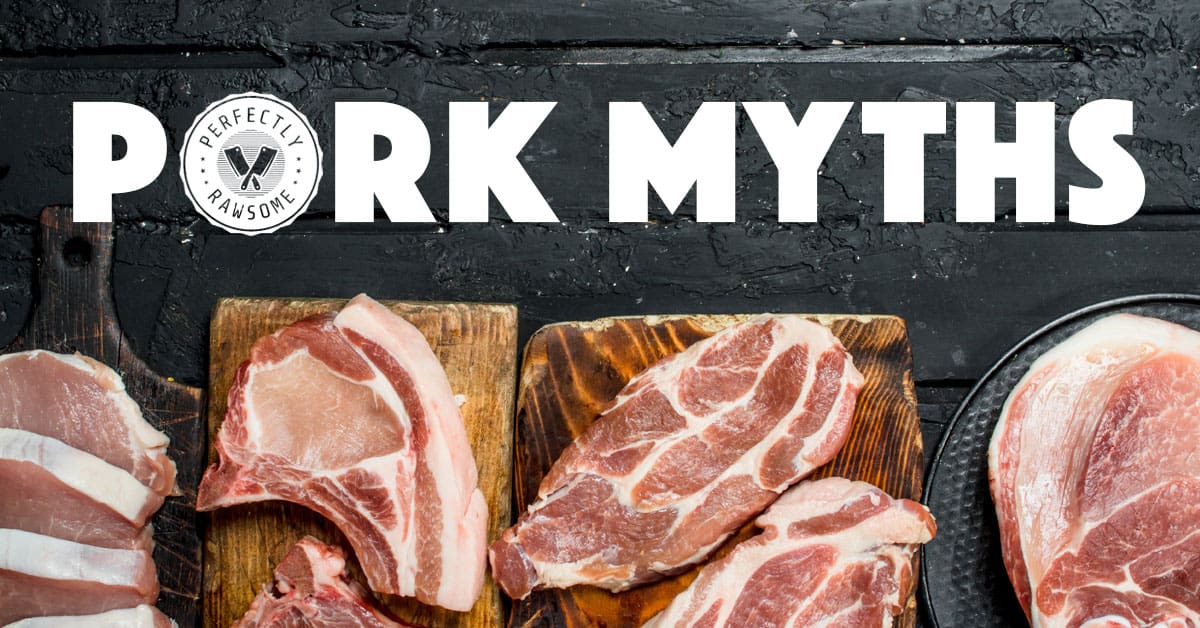
Source of Infectious Parasites
MYTH
Raw pork is riddled with parasites such as trichinella, tapeworm and toxoplasma.
FACT
While trichinella and other parasites were an issue many years ago, they are no longer a concern in commercially farmed pork in countries with updated husbandry practices and proper regulatory inspection.
Trichinella
Trichinosis is the term for infection by the parasitic worm species Trichinella spiralis. It is most common in wild carnivores and omnivores. According to the CDC: Trichinellosis used to be more common and was usually caused by ingestion of undercooked pork. However, infection is now rare. Cases have decreased drastically due to improved farming practices. Cases are less commonly associated with pork products and more often associated with eating raw or undercooked wild game meats.
The last reported case of human trichinosis from commercial pork in Canada was over 40 years ago, and there have been extremely few cases in the US.
Caution: Trichinella has been virtually eliminated in commercial pork in countries such as the US and Canada. However, the risk is higher with pasture raised pork that is in close proximity to wildlife and rodents. Additionally, it is important to consider that some countries do not have the same food inspection and husbandry laws and practices. Therefore, the risk of trichinella in pork should be considered by the specific country.
If trichinella is indeed a concern, the CDC recommends freezing pork less than 6 inches thick for 20 days at 5°F (-15°C) to kill any worms.
Tapeworm
According to the CDC: The highest rates of Taenia solium infection are found in Latin America, Asia, India and Africa in areas where people are concentrated, sanitation is poor and free-ranging pigs have access to human feces. Pigs become infected by eating human feces that contain tapeworm eggs. This is because humans are the primary host for T. solium while pigs are a secondary host.
Toxoplasma
The primary source of contamination of T. gondii in the environment is the domestic cat. Subsequently, the ingestion of oocysts from cats is the main mode of transmission for humans and dogs. Pigs and other meat animals can potentially contract Toxoplasmosis if they have access to cat or rodent feces.
According to this study by the Frontiers of Veterinary Science: Dogs rarely suffer from toxoplasmosis as a primary disease. In most cases, the disease is linked to immunosuppression and absence of vaccination against canine distemper virus. Clinical cases of toxoplasmosis are much more frequent in cats than in dogs. A high proportion of T. gondii clinical infections are triggered by immunosuppressive chemotherapy. In general, T. gondii infection is associated with a low rate of morbidity and mortality in dogs and cats.
Source of Deadly Viruses
MYTH
Commercial pork can transmit pseudorabies.
In the US, according to the USDA: No commercial total confinement production herds have been found to be infected with PRV since early 2003. Sporadic infections have been found in outdoor production herds or swine that have access to the outdoors where contact with feral swine is possible. Any infected herds have been promptly depopulated when found, and intense epidemiological investigations have been conducted to ascertain that no viral spread to commercial production swine has occurred.
Preliminary Caution:
Pseudorabies is still a concern in wild pigs in the US and other countries with reported incidence of the disease. It is not recommended to feed raw wild hog or raw meat from domestic pigs that may have come in contact with wild hogs. Pseudorabies has no treatment. It is usually fatal to dogs and cats, with death occurring suddenly within a short time after exposure. The virus is freeze-resistant and is only destroyed by heat above 160F (71C).
Difficult to Digest
MYTH
All pork is high in fat. Therefore, it is hard on digestion and will cause gastrointestinal stress such as gas, diarrhea, and even pancreatitis in severe cases.
FACT
All proteins will have varying levels of fats depending on the specific cut. While many cuts of pork are indeed high in fat, this is not inherently bad because fat is an essential nutrient. Additionally, there are some cuts of pork that are low in fat such as trimmed pork loin or sirloin.
Pork is not harder to digest than any other meat protein. In general, the digestibility of fresh meat is 85% to 95% digestibility which includes pork. Additionally, pork will not cause digestive stress in all pets. This myth originates from pet parents whose pet requires controlled levels of fat and/or has an intolerance to pork protein. However, the amount of fat a pet needs in their diet and food intolerances will vary greatly based on the individual. As with any other protein, some pets may not tolerate pork while others do very well on it.
Raw fat is the ideal energy source for carnivores. Pork cuts that are higher in fat can be paired with lean meaty bones and other lean ingredients. It is important to consider the overall fat level of the diet as a whole. The National Research Council (NRC) for dogs and cats provides recommended and maximum amounts for fat per 1000 kcal:
Adult Dogs
13.8g recommended allowance
82.5g maximum allowance
Puppies
21.3g recommended allowance
330g maximum allowance
Adult Cats
22.5g recommended allowance
82.5g maximum allowance
Kittens
22.5g recommended allowance
82.5g maximum allowance
The fat macronutrient allowance is used to encompass all essential fatty acid requirements in addition to fulfilling the needs for fat-soluble nutrient absorption, transportation, and supplying the body with energy. The fats in pork will not only provide fat as a macronutrient, but it will also supply fatty acids such as Linoleic Acid.
Below is a comparison of two different cuts of pork to illustrate the differences of fat between different cuts. The amount of calories, protein, fat, and carbs are based on 100 grams:
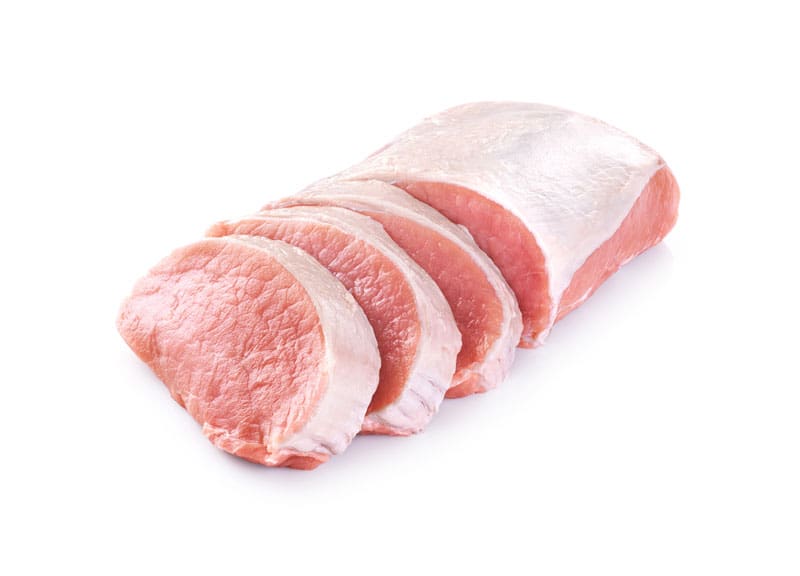
Pork Sirloin, lean only
The amount of calories, protein, fat, and carbs are based on 3.5oz (100g).
| Moisture | 73% |
| Protein | 23% |
| Fat | 4% |
| Carbohydrate | 0.6% |
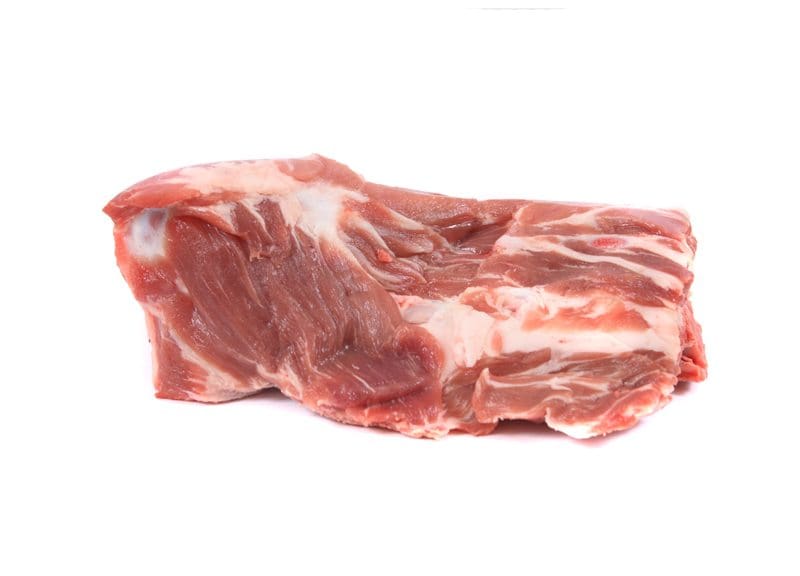
Pork Shoulder, lean and fat
The amount of calories, protein, fat, and carbs are based on 3.5oz (100g).
| Moisture | 64% |
| Protein | 17% |
| Fat | 18% |
| Carbohydrate | 1.6% |
Pets with existing pancreatitis should be fed a low fat diet which can be accomplished with leaner cuts of pork. A pork inclusive diet with appropriate raw fat levels for the pet’s individual needs will not cause pancreatitis. Pancreatitis can have several potential causes. However, the primary dietary trigger of pancreatitis is cooked fats rather than raw fats. Therefore, giving the family dog the leftover fatty gristle from the dinner roast should be avoided because this is a well known trigger for pancreatitis. Cooked diets will require the use of lean pork or other meats. Any fat should be added raw or cold pressed after the meat is cooked.
Pets with existing pancreatitis should be fed a low fat diet which can be accomplished with leaner cuts of pork. A pork inclusive diet with appropriate raw fat levels for the pet’s individual needs will not cause pancreatitis. Pancreatitis can have several potential causes. However, the primary dietary trigger of pancreatitis is cooked fats rather than raw fats. Therefore, giving the family dog the leftover fatty gristle from the dinner roast should be avoided because this is a well known trigger for pancreatitis. Cooked diets will require the use of lean pork or other meats. Any fat should be added raw or cold pressed after the meat is cooked.
Concentrated in Harmful Toxins
MYTH
Pork meat is toxic because pigs are dirty animals and cannot sweat to excrete toxins.
FACT
Pork meat is not inherently toxic or dirtier than any other meat source. This myth stems from a lack of understanding of a mammal’s physiology. Toxins are removed from the body by the organs rather than by sweating. Additionally, the pig’s reputation for being a dirty animal is largely undeserved.
The primary function of sweating is to lower body temperature. Pigs do have some sweat glands, however they do not sweat in order to cool down. Pigs will use other methods to cool off including rolling in water and mud. So while it is true that pigs sweat very little, this does not mean that they retain toxins. Their liver and kidneys function to remove toxins from the body and excrete them in urine and feces just like any other mammal.
Pigs have gained the reputation for being dirty animals due to their well known habit of wallowing in mud. However, pigs are actually very clean animals and highly intelligent. They will choose to defecate away from their eating and sleeping areas when given enough space. In developed countries commercially farmed pigs are kept in clean and climate controlled facilities.
Caution:
It is important to note that the same may not necessarily be said for pork raised in areas without sufficient regulatory inspection or clean farming practices. Parasites and other pathogens in pork and other meat animals can still be a concern where proper farming practices are not in place.
Inferior Source of Nutrition
MYTH
Pork is an inferior meat with little nutritional value.
FACT
The idea that any one protein is inferior reveals a lack of understanding about nutrition. Different proteins will vary in their nutritional composition. These variances are useful in different circumstances and no single protein should be considered “bad” or “better” than others.
All meat will provide high levels of essential protein, amino acids, fats, and fatty acids. Additionally, pork is notable for its high levels of B vitamins as compared to other proteins. This includes a high level of Thiamin which is often low in homemade raw and cooked diets. Combined with the fact that pork is typically a very affordable protein in most locations, this makes pork a very valuable addition to a fresh food diet.
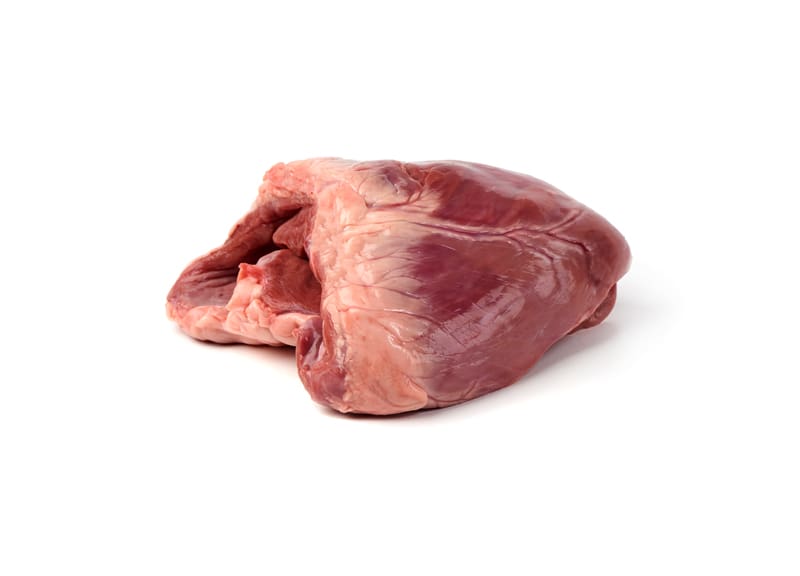
Pork Heart
The amount of calories, protein, and fat are based on 3.5oz (100g).
| Moisture | 76% |
| Protein | 17% |
| Fat | 4.4% |
| Thiamin | 0.613mcg |
Religious Limitations
Certain religions such as Judaism and Islam prohibit the consumption of pork. It is important to note that these limitations often extend to the household pet. Therefore, pets in households practicing these religions are also prohibited from consuming pork products and this should be respected. The freedom to practice religious beliefs is not a myth and should be treated with the utmost courtesy. Cats and dogs can still be fed a species appropriate fresh food diet without the use of pork. Although, an alternative source of B vitamins may be necessary.
CLOSING COMMENTS
The myths surrounding pork are numerous and it is important to consider negative statements about any protein with an accurate view of nutrition. While some of these myths are based on partial truths and past problems, others stem from the unreliable rumor mill.
The listed myths may not encompass all of the inaccurate and odd statements about pork, however the most common myths include the following:
Source of Infectious Parasites
Farmed pork raised for human consumption by using the appropriate and sanitary husbandry guidelines does not have an increased risk of parasites.
Source of Deadly Viruses
Deadly viruses such as pseudorabies have been eradicated in commercialized pork raised for human consumption. However, they still remain a risk in wild boar species and pasture raised pigs that have contact with wildlife.
Difficult to Digest
Pork is not harder to digest than any other meat protein. Additionally, pork itself will not cause digestive stress or pancreatitis.
Concentrated in Harmful Toxins
Pork does not have additional toxins within the meat because of their low number of sweat glands and their habits of wallowing in muddy water to cool off.
Inferior Source of Nutrition
Pork is an excellent source of protein, it provides a range of fat levels to accommodate low fat or high fat diets, and has a high level of B vitamins.
Fortunately, these myths are exaggerated, misunderstood, or inaccurate. They are an over inflation of misinformation or fear mongering about a protein that can be a great addition to a fresh food diet. However, some pet owners may still choose not to feed pork due to legitimate religious limitations or personal boundaries.

